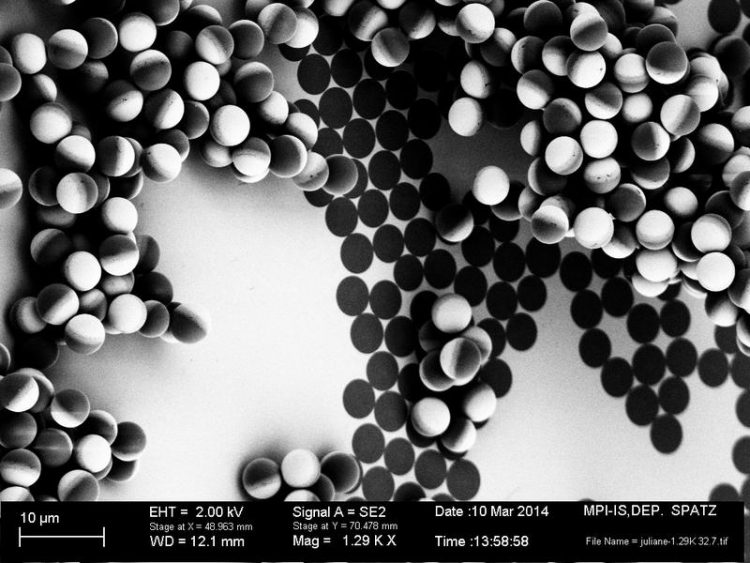Micromotors to open new horizons

Electron microscope image of nanoscale Janus particles, which the Freigeist-group is going to test regarding their capacity as photocatalytic nanomotors. Juliane Simmchen
The team will be researching a new kind of energy input for micromotors – fascinating novel devices bearing great potential for future technology.
A ‘Freigeist’ fellow: for the Volkswagen Foundation this means a young researcher with a strong personality, a creative mind, an ability to identify and use freedom, dedicated to overcoming resistance. Dr. Juliane Simmchen of TU Dresden is one of these extraordinary researchers who wants to overcome existing disciplinary boundaries to gain innovative insights.
During her doctoral thesis in Barcelona/Madrid and as a postdoc at the MPI in Stuttgart, she had been researching catalytic micromotors – a fascinating new field in the movement at the microscale connecting several disciplines of modern science. Micro- and nanomotors are novel devices which can transform energy into movement. Unlike large scale engines dominated by inertia, however, the movement of objects at the microscale requires a constant energy input.
Collaborating with the group of Prof. Eychmüller, Dr. Simmchen now aims at setting a new course in her work. With photocatalytic reactions on the surface of nanoparticles, the Freigeist group wants to research sunlight driven nanomotors. In combining the two innovative fields of photocatalysts and nanomotors, Dr. Simmchen wants to open new horizons for the use of nanomotors driven by renewable energy in several environmental and analytical applications.
So far, micromotors have been chemically or magnetically driven, often under the use of toxic chemicals. Photocatalytic micromotors, however, could be used for environmental remediation. Not only would using a renewable energy source (namely sunlight) drastically improve the general impact for the environment, sunlight driven micromotors would also increase the mixing and catalytic degradation of organic pollutants. Another potential application lies in novel sensors based on the observation of motion of fluorescently labelled molecules or biological markers. This might pave the way for high sensitivity detection and facilitate the mostly complex sample preparation though self-propelled isolation of the species in focus.
Media inquiries:
Dr. Juliane Simmchen
E-Mail: juliane.simmchen@tu-dresden.de
Media Contact
More Information:
http://www.tu-dresden.de/All latest news from the category: Life Sciences and Chemistry
Articles and reports from the Life Sciences and chemistry area deal with applied and basic research into modern biology, chemistry and human medicine.
Valuable information can be found on a range of life sciences fields including bacteriology, biochemistry, bionics, bioinformatics, biophysics, biotechnology, genetics, geobotany, human biology, marine biology, microbiology, molecular biology, cellular biology, zoology, bioinorganic chemistry, microchemistry and environmental chemistry.
Newest articles

High-energy-density aqueous battery based on halogen multi-electron transfer
Traditional non-aqueous lithium-ion batteries have a high energy density, but their safety is compromised due to the flammable organic electrolytes they utilize. Aqueous batteries use water as the solvent for…

First-ever combined heart pump and pig kidney transplant
…gives new hope to patient with terminal illness. Surgeons at NYU Langone Health performed the first-ever combined mechanical heart pump and gene-edited pig kidney transplant surgery in a 54-year-old woman…

Biophysics: Testing how well biomarkers work
LMU researchers have developed a method to determine how reliably target proteins can be labeled using super-resolution fluorescence microscopy. Modern microscopy techniques make it possible to examine the inner workings…





















